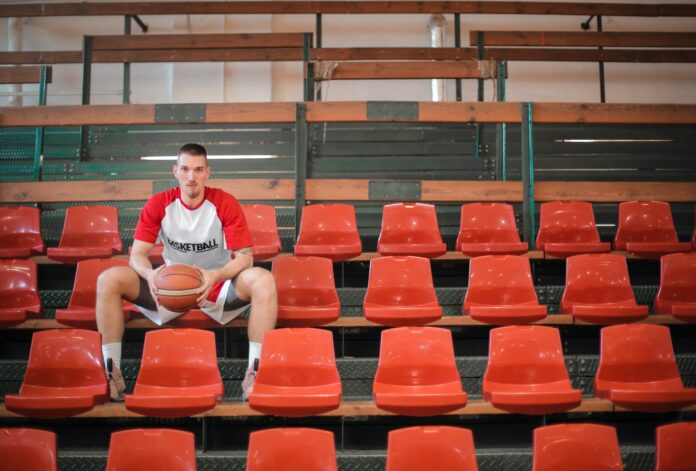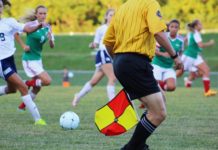
US Collegiate sport
The history of US collegiate sports begins in 1852: Students from Harvard and Yale participated in what many regard as the Nation’s first intercollegiate competition— a boat race at Lake Winnipesaukee, New Hampshire. Already this race was sponsored by a railroad executive. He offered the competitors an all-expenses- paid vacation with lavish prizes—along with unlimited alcohol – or, as the recent Supreme court decision puts it: “From the start, American colleges and universities have had a complicated relationship with sports and money.”
US Collegiate sport is organized by the NCAA, who organized the different leagues and championships the schools can compete in. Its membership comprises about 1,100 colleges and universities, organized into three divisions. Division I teams are often the most popular and attract the most money and the most talented athletes. As such, the NCAA implements rules on how to conduct sport on college level. The schools and athletes are bound by these rules through contracts, which are to be concluded at inauguration. In contrast to professional athletes competing in the major leagues (such as the NFL or NBA), collegiate athletes are considered students who are able to study at the respective university because of a scholarship – they are classed as amateurs by the NCAA. The respective rules of the NCA prohibit collegiate athletes to get paid for their services on the one hand and on the other to market their rights of image, name and likeliness.
While the collegiate athletes are classed as amateurs, over the decades the NCAA has become a sprawling enterprise. The NCAA’s current broadcast contract for the March Madness basketball tournament is worth $1.1 billion annually. Beyond these sums, the Division I conferences earn substantial revenue from regular-season games. For example, the Southeastern Conference (SEC) made more than $409 million in revenues from television contracts alone in 2017, with its total conference revenues exceeding $650 million that year. The president of the NCAA earns nearly $4 million. Also, college athletic directors average more than $1 million annually and annual salaries for top Division I college football coaches approach $11 million per year.
O’Bannon and Alston proceedings
In recent years, athletes challenged both, the prohibition to market name, image and likeliness, and the prohibition to receive money other than the scholarship for playing in college teams.
In 2009, former UCLA basketball player Ed O’Bannon, on behalf of the NCAA’s Division 1 football and men’s basketball players, brought a class action lawsuit in the United States District Court for the Northern District of California against the NCAA challenging the prohibition on marketing name, image and likeliness. O’Bannon argued that these rules violated U.S. antitrust laws. The NCAA asserted that its amateurism rules were necessary to uphold the NCAA’s educational mission and to protect the popularity of college sports. The District Court held that the NCAA’s amateurism rules were an unlawful restraint of trade in violation of U.S. antitrust laws. In the next instance, the Ninth Circuit held that the NCAA’s amateurism rules are subject to antitrust scrutiny. However, this court also held that the amateurism rules serve pro-competitive purposes, but it determined that the current rules were more restrictive than necessary to serve those purposes and that the NCAA could achieve its purposes in a less restrictive manner. Eventually, the US Supreme Court decided not to review the lower court decisions.
In 2014, Alston, a Division 1 football player, took action because he thought the rule, limiting his compensation to the scholarship violated US antitrust law by barring the athletes from receiving fair-market compensation for their services. The same federal district court in California as in the previous O’Bannon proceeding agreed in part: it ruled that the NCAA could only restrict benefits that are unrelated to education (such as cash salaries), but it barred the NCAA from limiting education-related benefits. Here, the court argued that while the non- education related benefits might be considered price-fixing, these limits might be reasonable: this is because professional level cash might blur the line between amateurism and professional sport.
After the U.S. Court of Appeals for the 9th Circuit upheld that decision and unsatisfied with the outcome, the NCAA and the athletic conferences went to the Supreme Court, which late last year agreed to take up the case.
The Supreme Court decision in NCAA v. Alston
The justices unanimously upheld the lower court’s decision. In particular the court held that the NCAA rules limiting the compensation for athletes violate US antitrust law insofar as they forbid education related benefits.
While it was undisputed that the NCAA as such has a monopoly and its rules restrict competition, the NCAA disputed that the so-called “rule of reason test” should be applied. However, the court held that the “rule of reason test” has to be applied, and exceptions can only be made when less stringent tests apply only in extreme cases, when it is easy to determine what impact an agreement will have on competition. That is not the case here, Judge Gorsuch stressed, because the NCAA and its members control the market for the services of college athletes.
Under this test, the NCAA still argued that the Supreme Court itself held in 1984 in NCAA v. Board of Regents of University of Oklahoma, involving an antitrust challenge to the NCAA’s plan to televise college football games that the NCAA’s actions to preserve amateurism are “entirely consistent” with the federal antitrust law. However, the court must not reflexively reject all challenges to the NCAA’s compensation restrictions. Realities of college sports have changed significantly since 1984. Still, the association seemed to be seeking a sort of judicially ordained immunity from federal antitrust law merely because “its restrictions involve the intersection of higher education, sports, and money.”
Reading the decision it is particularly interesting that the court unanimously upheld the lower court’s decision. Moreover, as he delivered a concurrent opinion, Judge Kavanaugh explained that the NCAA’s remaining compensation rules also raise serious questions under the antitrust laws. He argued that the NCAA’s argument that its compensation rules are procompetitive because those rules help define the product of college sports is circular and unpersuasive. The NCAA would couch its arguments for not paying student athletes in innocuous labels – however labels cannot disguise reality: the NCAA’s business model would be flatly illegal in almost any other industry in America because it would be considered price fixing. It is highly questionable whether the NCAA and its member colleges can justify not paying student athletes a fair share of the revenues on the circular theory that the defining characteristic of college sports is that the colleges do not pay student athletes.
What’s next for US collegiate sports?
On quite short notice, the NCAA is now required to change its rules, in order to comply with the US Supreme Court’s ruling.
However, this is not the end in the saga of US college sports. Already in July 2021 new legislation comes into force in certain US states, such as Florida. This legislation is a direct consequence of the previous O’Bannon ruling and secures the rights of college athletes to receive compensation for marketing their name, image and likeliness; however, only a few states have enacted such legislation. Therefore, it is expected that federal legislation will be put in place. Certain bills are already being discussed in this regard, but these still have to pass congress. It remains to be seen how far the future legislation will go and if it – following the Alston ruling and in particular the concurrent opinion – it will include rules on payment for collegiate athletes.
If you want to find out more about this case and the background, you can find Ansgar’s podcast on the topic here.









